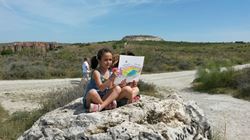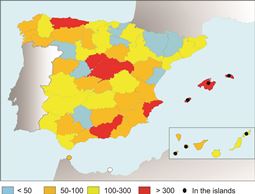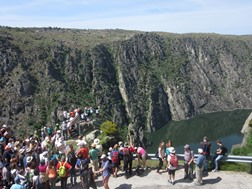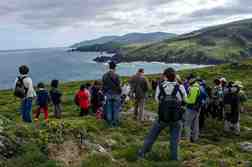Ana Maria Alonso-Zarza1 and friends2-5 describe Spain’s hugely successful field-based outreach programme ‘Geology day’
 Science – perhaps especially geological science - is not as close to society as it should be, and so in recent times many different scientific organisations, universities and research institutes have been making a great effort to get lay-people interested through a variety of resources and activities.
Science – perhaps especially geological science - is not as close to society as it should be, and so in recent times many different scientific organisations, universities and research institutes have been making a great effort to get lay-people interested through a variety of resources and activities.
In Spain one such initiative, Geolodía (‘Geo-day’), is trying to bring geology closer to the general public through our most powerful tool - the observation of landscapes and rocks in the field. To this end we organise one free geological field trip in each of Spain’s 52 provinces, as well as some extra ones within the various islands.
Voluntary
The latest, Geolodía 15, took place on 9 and 10 May 2015, with nearly 9000 people attending its 54 field excursions, guided by c. 500 volunteers. The incredible success we have seen in recent years has been the result of the continued involvement and voluntary work of many professionals, many from the very outset of this outstanding project.
 Both the term ‘Geolodía’ and subsequent activities originated in 2005 in Teruel province, when J L Simón and L Alcalá organised, for non-geologists, a Sunday field trip to the Geological Park of Aliaga (now part of El Maestrazgo Geopark, included in the Global Geopark Network of UNESCO).
Both the term ‘Geolodía’ and subsequent activities originated in 2005 in Teruel province, when J L Simón and L Alcalá organised, for non-geologists, a Sunday field trip to the Geological Park of Aliaga (now part of El Maestrazgo Geopark, included in the Global Geopark Network of UNESCO).
Its aim was to make people familiar with the geology of the area and show its value. From 2005 to 2009, various provinces (Guadalajara, Alicante, Valencia, Huesca, Segovia and Zaragoza) joined the initiative, but all on different dates. In 2010 the Geological Society of Spain (SGE) took over coordination of Geolodía, and since then it has been celebrated on the same weekend (the second in May) all around the country.
These dates, considered the most convenient, are an attempt to hit on ‘Goldilocks’ weather conditions – which should be not too cold in mountain areas, and not too warm in the south - regardless of the basically unpredictable nature of the weather everywhere! Conducting all the excursions during the same weekend lends greater media visibility to the activity, allowing geology to become a news focus. It also provides continuity from one year to the next, so that keen participants can be confident to book that weekend in their diaries every year.
Provinces
Geolodía10 (2010) was the first to be organised at national level, when 36 provinces of Spain joined the initiative and about 5400 people attended. Geolodía11 was celebrated in all Spanish provinces, and since then the number of participants and organisers has continuously increased. The map (above right) shows the number of participants in its latest manifestation (Geolodía15) in the various provinces and archipelagos.
Throughout, Geolodía has tried:
- to teach how to regard, the environment in which we live with ‘geological eyes’; how to read the language of rocks and landscape as the pages of the book telling the long history of our planet;
- to explain the effects that some geological processes (earthquakes, volcanoes, floods,…) have on the surface of our planet and thus on our lives, and how to minimise associated risks;
- to show how various natural geological resources are obtained, their uses and their sustainable management;
- to exhibit our rich and varied geological heritage in order to spread knowledge of it and protect it;
- to illustrate the work of geologists while revealing how they contribute to the well-being of society, and to encourage young people to become geologists.
Geolodía is coordinated by the Geological Society of Spain (SGE) with the collaboration of the Spanish Association of Earth Science Education (AEPECT), and is mostly funded by the Spanish Foundation for Science and Technology (FECYT), the Spanish Geological Survey (IGME) together with a pool of universities, research institutes, local administrations and industries.
Budget
 The overall budget and cost of Geolodía15 was €48,400. The Geological Society of Spain applied to FECYT under the project title Geolodía15: Geology for the general public, and was given €24,000. IGME contributed €5,000. The rest came from a variety of organisations. About half of the budget (€25,400) was spent in travelling costs, such as buses, or to cover the preparation costs and travelling of field-trip leaders. The other half (€23,000) was used in producting guides, posters and security vests.
The overall budget and cost of Geolodía15 was €48,400. The Geological Society of Spain applied to FECYT under the project title Geolodía15: Geology for the general public, and was given €24,000. IGME contributed €5,000. The rest came from a variety of organisations. About half of the budget (€25,400) was spent in travelling costs, such as buses, or to cover the preparation costs and travelling of field-trip leaders. The other half (€23,000) was used in producting guides, posters and security vests.
This sum did not really cover the total cost, since salaries were not included at all, and many small costs were covered directly by local organisations and are not therefore included in the general budget. The support from FECYT and IGME are critical in organising Geolodía, as it forms the basic funding resource available to the SGE (Geological Society of Spain). In future the aim is to obtain some financial support from private companies, but so far we have had no success.
The overall coordination and program of Geolodía is carried out by a relatively small group of people led by the President of the Geological Society of Spain and a representative of the Spanish Geological Survey. This group receives proposals from local organisers in each province, and searches for potential organisers in provinces lacking proposals. Usually by January the entire programme is arranged. Once the leaders in each province are appointed, the task is to organise every field trip and to prepare material.
The selection of the area to be explored by the different field trips is left up to the local organisations, based mainly on both quality of outcrop and beauty of landscape, but also on accessibility and security. Once the leaders and localities are chosen, local organisers prepare a poster to announce the activity through the web, media and social networks.
Numbers
 Field trips are carried out in different ways according to numbers. Easiest for organisers is a trip by bus, with just a few leaders explaining all the various stops. This does not however work well where a large attendance is expected. For bigger events (>100 participants), the most suitable method is to find an easy walking path along which a number of leaders can station themselves at the different stops, and explain them as the public passes by during the day. This requires a large number of leaders and the participation of many students to help with logistics and explanations.
Field trips are carried out in different ways according to numbers. Easiest for organisers is a trip by bus, with just a few leaders explaining all the various stops. This does not however work well where a large attendance is expected. For bigger events (>100 participants), the most suitable method is to find an easy walking path along which a number of leaders can station themselves at the different stops, and explain them as the public passes by during the day. This requires a large number of leaders and the participation of many students to help with logistics and explanations.
Alicante and Segovia provinces have pioneered this type of large-scale trip, supporting in some cases more than 2000 participants each. In addition to the organisation itself, the local committee elaborates a simple but well-illustrated field guide written in an easy non-technical style. All of these guides are made available on the SGE website www.sociedadgeologica.es/divulgacion_geolodia.html, so we are gradually accumulating a huge amount of material that can be used for teaching, tourism or to promote rural development. Once the yearly activity is over it is recorded in a photographic summary containing one image from each field trip. You can see a selection of these in this article.
Geolodía is becoming very popular in Spain, especially with people fond of nature. In future we aim to focus on two things. The first is to improve and make more uniform the style of the field trips, and to explain the main, basic geological concepts in a simple way, using high quality sketches. Our experience confirms people´s enjoyment of beautiful landscapes; but the look on their faces, when they understand and feel, for example, what a geological fault really is, is incredible.
We hope also to widen this initiative into neighboring countries. At present, Andorra has joined the initiative and we hope more countries will follow.
Authors
Zarza, A M1, Aurell, M2, Carcavilla, L3, Corral, I4, Crespo-Blanc, A5.
- Geological Society of Spain, Facultad de CC. Geológicas, Universidad Complutense Madrid, IGEO, CSIC (Spain)
- Geological Society of Spain, Departamento Ciencias de la Tierra, Universidad de Zaragoza (Spain)
- Geological Society of Spain, IGME, Rios Rosas, 22, Madrid (Spain)
- Geological Society of Spain, Facultad de Ciencias, Universidad de Salamanca (Spain)
- Geological Society of Spain, Departamento Geodinámica-IACT, Universidad de Granada (Spain)